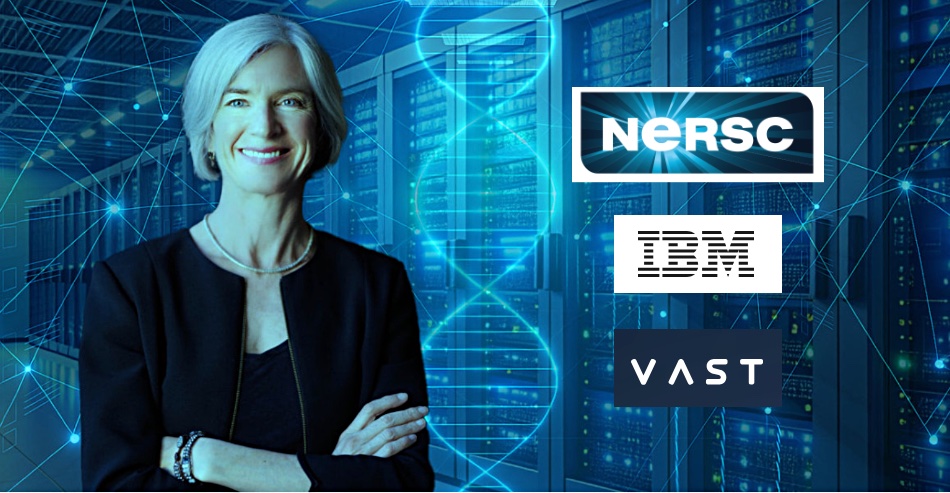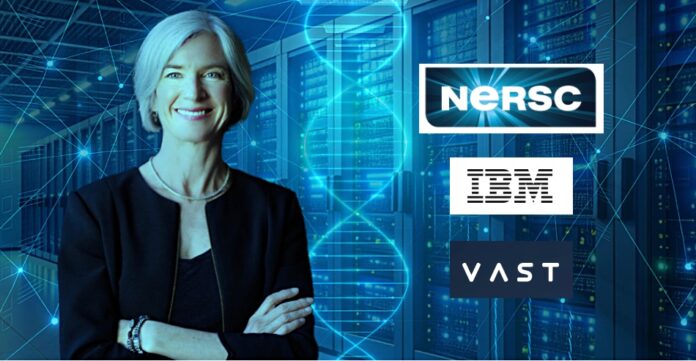VAST Data is supplying an AI-focussed storage system for the Doudna supercomputer, sharing the storage billing with IBM’s Storage Scale and its traditional high-performance computing (HPC) parallel file system.
Doudna is a NERSC-10 supercomputer, NERSC being the National Energy Research Scientific Computing Center. It is operated by the Lawrence Berkeley National Laboratory for the United States Department of Energy’s Office of Science, with the University of California managing the Lawrence Berkeley National Lab. NERSC was founded to support fusion research, and Doudna will provide supercomputational power for research into fusion energy, as well as quantum computing simulation. It will also enable DOE-funded researchers to integrate large-scale AI into their simulation and data analysis workflows.
U.S. Secretary of Energy Chris Wright said: “The Doudna system represents DOE’s commitment to advancing American leadership in science, AI, and high-performance computing. It will be a powerhouse for rapid innovation that will transform our efforts to develop abundant, affordable energy supplies and advance breakthroughs in quantum computing. AI is the Manhattan Project of our time, and Doudna will help ensure America’s scientists have the tools they need to win the global race for AI dominance.”
The NERSC-10 system is called Doudna after Jennifer Doudna, the Berkeley Lab-based biochemist who was awarded the 2020 Nobel Prize for Chemistry in recognition of her work on the gene-editing technology CRISPR. Doudna’s storage performance will be up to five times faster than NERSC’s current – Perlmutter or NERSC9 – system and offer performance guarantees for time-sensitive science. Doudna’s computational performance will be ten times greater than Perlmutter.
It is a Dell system, with ORv3 direct liquid-cooled server technology, using Nvidia’s Vera Rubin platform composed from “Rubin” GPUs and “Vera” Arm CPUs. It has two roles; supporting large-scale HPC workloads like those in molecular dynamics, high-energy physics, and, secondly, AI training and inference.
Doudna’s architects have selected two storage systems, one for each role; a quality-of-service storage system (QSS) for the AI work and a platform storage system (PSS) for the traditional HPC storage needs.
PSS storage will be provided by IBM’s Storage Scale, a long-term and popular high-performance parallel file system for modeling and simulation workloads running at scale. The QSS will use VAST Data. Both are all-flash systems. This is a big win for VAST, marking its entry into an HPC, parallel file system, citadel
VAST’s win was hinted at in June. Now it’s confirmed that Doudna will use VAST Data’s AIOS (AI Operating System) which “unifies data storage, database, compute, messaging, and reasoning capabilities into a single, data-centric infrastructure built from the ground up for AI and agentic workflows.”
VAST Co-founder Jeff Denworth stated: “With the VAST AI Operating System, NERSC is pioneering a new model for Doudna, where users get guaranteed performance, security, real-time access, and built-in data services – without the operational friction of traditional HPC systems. Together, NERSC and VAST are setting the blueprint for exascale computing, enabling breakthrough capabilities that will define the next era of scientific computation.”
NERSC HPC architecture and performance engineer Stephen Simms said: “The addition of quality-of-service [QSS] will provide predictable performance through fine-grained control of file system capability. This partnership will further our aim to enhance the user experience in the service of science.”
The IBM Storage Scale system will be all-flash parallel scratch filesystem supporting file and object access. It, NERSC said, “delivers high speed, scalable performance, and automated efficiency designed to help eliminate bottlenecks and streamline data workflows, empowering researchers to focus on discovery instead of infrastructure management.”
IBM’s Vanessa Hunt, GM, Technology, US Federal Market, bigged up Storage Scale’s management ease, stating: “IBM Storage Scale is purpose-built to support the next wave of American innovation – delivering the speed, flexibility, and reliability needed to power breakthrough discoveries, while simplifying data management in even the most complex HPC environments.”
Denworth posted a comment on X: “First met NERSC in Jan of ’18. Longest sales cycle ever 🙂 I’ve been telling everyone for years that NFS is suitable for hyperscale HPC, now it’s happening. If you want “Quality” choose @VAST_Data.”
It doesn’t actually appear to be happening though, as NERSC is using Storage Scale for the trad HPC workloads with VAST selected for the AI work.
Bootnote
(1) The Next Platform published a Doudna article looking at the compute side here.
(2) We understand that Doudna’s storage architecture includes tiering, which optimizes data placement across different storage layers to balance performance and capacity. This suggests there is a disk-based backing store.

